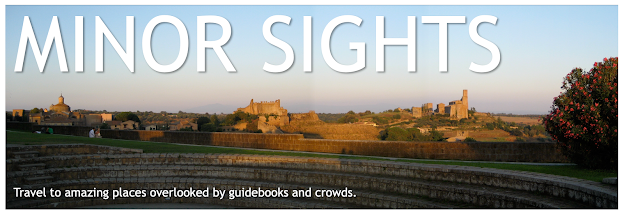 |
| Detail of the Loggia of Psyche. |
One of Raphael’s most famous frescoes, hidden in a Roman villa,
Why visit?
Whereas one has to endure unbearable crowds to see Michelangelo’s frescoes in situ, that other Renaissance genius, Raphael, left one of Western art’s iconic masterpieces, The Triumph of Galatea, in a quiet Villa in the heart of Rome that attracts as many visitors in a day as the Sistine Chapel in 30 seconds.
Where?
In Via della Lungara, in Trastevere, overlooking the Tiber river, just around the corner from the restaurants offering tourist menus in seven (or more!) languages. Map.
THE VILLA FARNESINA is named for the papal Farnese family, who also owned the Palazzo Farnese in Caprarola. They did not, however, build it.
Villa Farnesina was built by Agostini Chigi, a Sienese banker who, like a 16th century Goldman Sachs, provided creative financial support for the Vatican. And much like contemporary investment bankers, he was rolling in dough.
 |
| The Villa Farnesina, seen from the garden. Notice all the tourists. |
He built his Villa just outside the city walls (you’ll pass through them coming from Trastevere), near the Vatican and the Villa Giulia where his rich customers lived. Legend has it that at Chigi's parties, the expensive crockery was thrown into the Tiber, for fun (once you see how far the Tiber actually is, you'll probably conclude it is just that: a legend)
In keeping with his wealth and standing, no expense was to be spared. He hired the city’s best talent, which included Raphael, as well as a number of other artists, including the painter known as Il Sodoma, who, proudly out of the closet, made no secret of where his sexual preferences lay.
Raphael and his team got to work, but only a few of the works were painted by Raphael himself. Apparently he was too busy dilly-dallying with his girlfriend (looking at her portrait, one can’t entirely blame him) and most of the work was done by the others, following Raphael’s designs.
When Raphael finally bothered to show up, he painted what is undoubtedly the highlight of the Villa, and one of Rome’s supreme (if much under-visited) works of art: The Triumph of Galatea, which shows what appears to be a water-skiing sea nymph named Galatea. Having escaped from entrapment by Polyphemus, a possessive misogynist, Galatea escapes with the aid of two dolphins and a large shell.
The other highlight of the Villa is the Loggia of Psyche, which relates the full story of the two love birds Psyche and Cupid, whilst visually name checking every Greek/Roman god in town. It’s a stunning work of art, painted on the loggia’s ceiling, and worth a sore neck. The Villa’s management has kindly provided some lazy chairs in which you can recline and take in the Elysian spectacle.
Unlike with Raphael or Sodoma, we don't know much about Chigi’s sex life. But we do know he wanted some kinky pictures for his bedroom. It was decorated by Il Sodoma with scenes from the marriage of Alexander the Great and the Persian princess Roxana. One of the images shows Roxana having her clothes ripped off by a bunch of cherubs- now that she’s married it’s time to enjoy the fringe benefits of marriage and Alexander himself is seen waiting in eager anticipation.
 |
| Roxana tries to preserve her modesty as cherubs enthusiastically get her ready for the consummation of her marriage. |
Getting there:
Stroll your way to the Villa Farnesina from either Trastevere’s centre or the Vatican. Note that the Villa is generally only open in the morning.
Useful links:




Comments
Post a Comment
Have you been here? Or are you planning to go? Either way, we would love to hear about it.